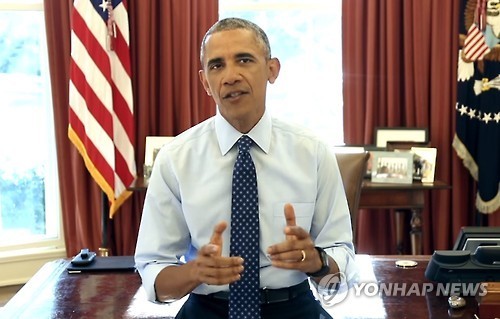The United States and Russia agreed Monday on a new cease-fire for Syria that will take effect Saturday, even as major questions over enforcing and responding to violations of the truce were left unresolved. Where in Syria the fighting must stop and where counterterrorism operations can continue also must still be addressed.
The new timeline for the hoped-for breakthrough comes after the two former Cold War foes, which are backing opposing sides in Syria’s civil war, agreed on terms for the “cessation of hostilities” between Syrian President Bashar Assad’s government and armed opposition groups. Those sides must accept the deal by Friday.
 |
| (Yonhap) |
The truce will not cover the Islamic State, the al-Qaida-linked Nusra Front and any other militias designated as terrorist organizations by the U.N. Security Council. Both the U.S. and Russia are still targeting those groups with airstrikes. The State Department made the five-page plan public after Presidents Barack Obama and Vladimir Putin spoke by telephone Monday.
The war has killed more than 250,000 people, created Europe’s worst refugee crisis since World War II and allowed the Islamic State to carve out territory across Syria and neighboring Iraq. Independent of Russia, a U.S.-led coalition is carrying out a separate bombing campaign in Syria, targeting IS militants.
Even if the cease-fire takes hold, fighting will by no means cease in Syria.
Russia will surely press on with an air campaign that it insists is targeting terrorists, but which the U.S. and its partners say is mainly hitting “moderate” opposition groups and killing civilians. While IS tries to expand its self-proclaimed caliphate in Syria and neighboring Iraq, al-Nusra is unlikely to end its effort to overthrow Assad. The Kurds have been fighting IS, even as they face attacks from America’s NATO ally Turkey. And Assad has his own history of broken promises when it comes to military action.
All of these dynamics make the truce hard to maintain.
“If implemented and adhered to, this cessation will not only lead to a decline in violence, but also continue to expand the delivery of urgently needed humanitarian supplies to besieged areas and support a political transition to a government that is responsive to the desires of the Syrian people,” Secretary of State John Kerry said in a statement.
“We are all aware of the significant challenges ahead,” Kerry said. “Over the coming days, we will be working to secure commitments from key parties that they will abide by the terms.”
The plan largely follows the blueprint set by Washington, Moscow and 15 other countries at a conference in Germany earlier this month. That agreement called for a truce by Feb. 19, a deadline that was missed.
Beyond the new cease-fire date, Monday’s agreement sets up a “communications hotline” and, if needed, a working group to promote and monitor the truce. Violations are to be addressed by the working group with an eye toward restoring compliance and cooling tensions. The deal also calls for “non-forcible means” to be exhausted before other means are pursued for punishing transgressors.
Any party can report violations to the working group being co-chaired by the U.S. and Russia.
The two countries also will share “pertinent information” about territory held by rebels accepting the truce.
These groups must “cease attacks with any weapons, including rockets, mortars, and anti-tank guided missiles, against Armed Forces of the Syrian Arab Republic, and any associated forces,” according to the agreement.
Assad’s military and Russia, in turn, have to halt aerial bombardments against opposition forces, and stop trying to seize territory from them. They also must “allow humanitarian agencies rapid, unhindered and sustained access throughout areas under their operational control and allow immediate humanitarian assistance to reach all people in need.”
When responding in self-defense, they should use only “proportional use of force.” (AP)

